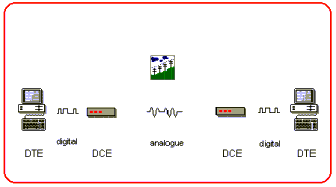![]()
DATA
COMMUNICATIONS
© Copyright Brian Brown, 1995-2000. All rights reserved.
Modems | Smart Modems | AT Commands | Standards | Summary
Introduction
This section briefly discusses modems, what they are, what they
are used and a summary of the standards associated with them.
Objectives
At the end of this section you should be able to
![]() Modems
Modems
Modems are devices that allow digital
data signals to be transmitted across an analogue link. As has already been
discussed, the connections provided by telephone companies for
the use of speech via dial up telephones is analogue based.
However, in recent times, with the development of on-line
information boards (bulletin boards) and the Internet, it is now standard
practice to want to use the dial-up
telephone connection to access these services.
As the computer uses digital information, and the telephone line uses analogue signals, a device is needed which converts the digital data from the computer and converts it to analogue tones (within the voice channel range of 300Hz to 3400Hz) so that the signals can travel across the dial up speech connection. At the other end, the signals are converted back to digital. The device that converts digital signals to analogue for transmission across a dial-up telephone connection, and then converts them back again, is a modem.
 |
Modem stands for modulator demodulator. A modem changes the digital signal to an analogue frequency, and sends this tone across the analogue link. At the other end, another modem receives the signal and converts it back to digital. |
A modern modem looks like,

![]() Smart Modems
Smart Modems
This is a standard modem with a micro-processor to provide both
data communications and automatic dialing in the one unit. These
modems offer a range of features,
![]() Modem Commands
Modem Commands
Modems can receive and act on commands from the computer
terminal. Commands begin with the symbol AT and are terminated
with a carriage return.
The range of commands is called the AT Command Set. This is detailed in the reference listed above. Depending upon how the modem is configured (whether to echo results of commands), the modem will return the symbol OK in response to a command request if it is performed.
![]() The AT Command Set
The AT Command Set
Hayes Corporation developed a smart modem that accepted AT type
commands. This is now a widely accepted standard. The following
is a brief list of the AT command set.
![]() ITU V.XX Modem
Standards
ITU V.XX Modem
Standards
The International Telegraphic Union (ITU) is an international
organization responsible for the establishment of the world wide
V standards.
| V Series Standard | Details |
| V.22 | 1200bps full duplex 2 wire dial-up for use in general telephone networks |
| V.22 bis | 2400bps dial-up or 2 wire leased line |
| V.23 | 600/1200bps dial-up for use in general telephone networks |
| V.26 bis | 2400/1200bps dial-up for use in general telephone networks |
| V.27 | 4800bps leased line |
| V.27 bis | 4800/2400bps leased line with automatic adaptive equaliser |
| V.27 ter | 4800/2400bps dial-up for use in general telephone networks |
| V.29 | 9600bps leased line |
| V.32 | 9600bps dial-up for use in general telephone networks |
| V.32 bis | 14400bps dial-up for use in general telephone
networks or leased line, synchronous or asynchronous full-duplex |
| V.33 | 14000bps over 4 wire leased line, synchronous full-duplex |
| V.34 | 28800bps dial-up for use in general telephone
networks or leased line, synchronous or asynchronous full-duplex |
| V.34 Enhanced | 33600bps dial-up for use in general telephone
networks or leased line, synchronous or asynchronous full-duplex |
| V.35 | 48Kbps using 60-108Khz group-band circuits |
![]() Summary
Summary
A modem is required to send digital data
over an analogue connection such as a dial up telephone line.
Modems change the digital data to analogue tones that fit within
the frequency range of the voice channel. A modem can also
convert these analogue tones back to the original digital data.
Nowadays, it is common for the home user to access the Internet via a dial up telephone connection using a modem. Typically, these modems run at 28.8Kbps or 33.3Kbps, although 56.6Kbps modems are now becoming available.